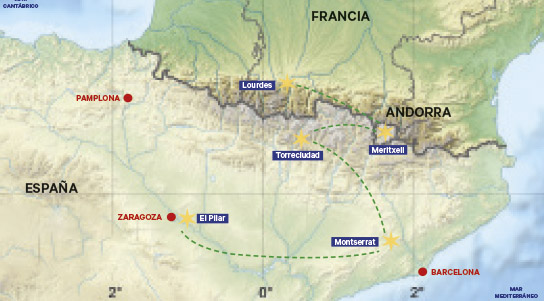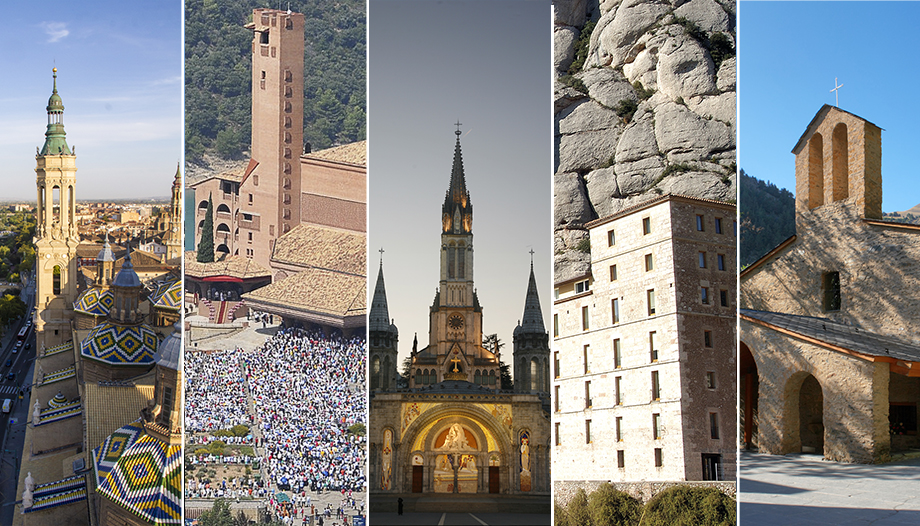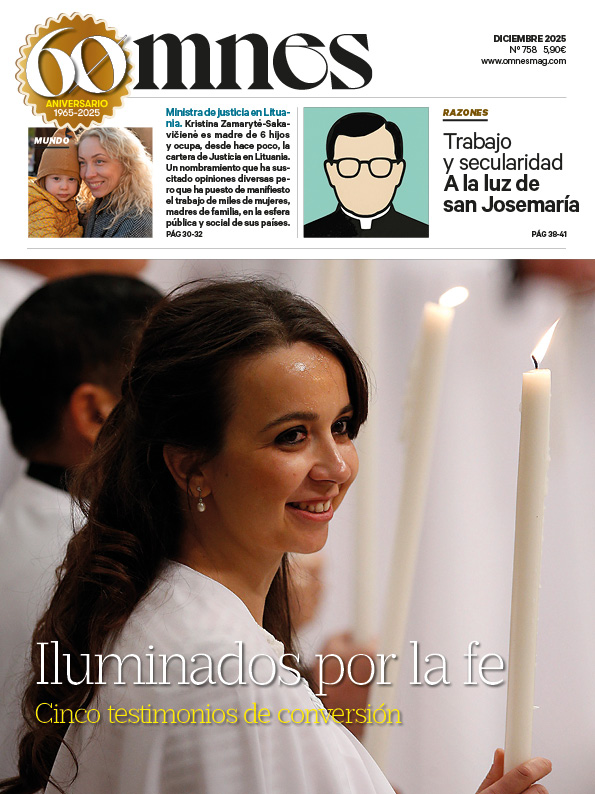In Spain alone, nearly 15 million people travel annually for religious reasons. Among these, Holy Week stands out, which in Spain enjoys numerous key points and celebrations that have been declared of Cultural Interest or even Intangible Heritage of Humanity, along with destinations such as Rome or the Holy Land.
But religious tourism also has one of its key development axes in the Marian sanctuaries scattered all over the world. An example of this strength and of the future of religious tourism is the Marian Route which unites five sanctuaries in three countries: Spain, France and Andorra, in a pilgrimage that combines faith, culture, devotion and promotion of territorial development.
Long before the establishment of the association Marian Route This was the name given to the ancient Marian road that stretched from the Basilica of Pilar to the sanctuary of Lourdes, passing through Torreciudad.

The Marian Route
The association Marian Route was born shortly after the Universal Exposition of Zaragoza, in 2008. The priest Javier Mora-Figueroa, then rector of the Sanctuary of Torreciudad, and José Joaquín Sancho Dronda, president of the Board of Trustees of Torreciudad, came into contact with Aradexthe company in charge of the Expo's communication. After attending with them several congresses on religious tourism, they promoted an association of sanctuaries that gave rise to what today is the association Marian Route which had the collaboration and support of the Government of Aragon and the City Council of Zaragoza.
In fact, the association is made up of the various Marian sanctuaries, and in a certain sense, their rectors are the "owners" of Marian Route, who decide on the lines of action or if, for example, a sanctuary that is within this pathway meets the requirements to be part of the Marian Route.
From Marian Route emphasize that "is something different. It is true that it is a path of spirituality. However, it is also a journey that combines devotion and meditation with culture, art and nature. The sanctuaries of El Pilar, Torreciudad, Montserrat, Meritxell and Lourdes help -and a lot, as the experience of all these years tells us- to make this itinerary valid for pilgrims who come for religious reasons as well as for visitors who are attracted by history or by the artistic, architectural and natural beauty of the temples and their surroundings. For this reason, the Marian Route is visited by believers and heritage lovers alike".
Devotion, faith and culture
Since its inception, the Marian Route is based on a clear idea: to promote knowledge of the shrines of the Virgin Mary and Marian devotion and, at the same time, to be agents for the development of the environment. This is the hallmark of Marian RouteThe proposal is marked by a religious character that does not forget the culture, gastronomy or other notable aspects of the areas in which the Marian sanctuaries are located.
The combination offered from Marian Route makes it possible for the tourist to have different fields to enjoy and for the experience to be a joint one. In this sense, as highlighted in Marian Route, "It is a plural and multicultural itinerary where each sanctuary has its own qualities and characteristics and whose enclaves offer an important and varied range of tourist attractions"..
For this reason, Marian Route should not be understood as a travel agency, but as the closest thing to the tourism delegations of a community: that is, a tool on which tour operators rely to organize their trips, and the media to publicize the various sanctuaries of the Virgin of the route.
The Basilica on the Pillar of the Virgin Mary
In the heart of Zaragoza, on the banks of the Ebro River, stands the Basilica of Our Lady of Pilar, easily accessible by train, bus, car or plane. The sanctuary is free to enter and is open daily, Monday through Saturday from 6:45 am to 8:30 pm and Sunday from 6:45 am to 9:30 pm.
Some important places to visit in the surroundings are the Aljafería Palace, the cathedral of La Seo or the vestiges of the Caesaraugusta Roman. But Zaragoza also has many other points of interest. Another interesting route that can be followed in the city is the one that follows in the footsteps of the painter Francisco de Goya, who lived in the city during part of his childhood and adolescence and whose different works are preserved there.
Torreciudad, sanctuary of families
The sanctuary of Torreciudad is located in the province of Huesca, and is a meeting point for thousands of families and pilgrims. It is well connected both with the surrounding towns and with France, making it possible to reach the sanctuary of Lourdes from there in three hours, thanks to the Bielsa tunnel, under the Pyrenees. The sanctuary is free to enter and its opening hours change according to the months of the year: July and August from 10 am to 8:30 pm; from May to October from 10 am to 7 pm; and from November to April, Saturdays and Sundays from 10 am to 7 pm and Mondays to Fridays from 10 am to 2 pm and from 4 pm to 6 pm.
In addition to the sanctuary, it is possible to visit the Multimedia Space Live the experience of faith, which shows in a dynamic and current way the message of the Gospel, with technology such as virtual reality glasses.
In the vicinity of Torreciudad there are numerous places of tourist interest: Loarre Castle; Barbastro, where you can visit the Cathedral of Our Lady of the Assumption and the Barbastro-Monzon Diocesan Museum; the medieval village of Alquézar, where you can follow the route of the Vero Footbridges, the Natural Park of the Sierra and Canyons of Guara, and visit some of the wineries of the Somontano Designation of Origin; the recovered villages of Ligüerre de Cinca or Morillo de Tou; as well as beautiful places like Roda de Isábena, with the ex-cathedral of San Vicente, considered the oldest in Aragón, Aínsa, Boltaña, Fonz, Monzón, Graus, or the National Park of Ordesa.
Lourdes, the place of apparitions
The sanctuary of Lourdes is located in the south of France, in the Hautes-Pyrénées. It can be easily reached by car and the town has both paid and free parking facilities. Another possible means is by plane, since there are two international airports near the sanctuary: Tarbes Lourdes Pyrenees and Pau Pyrenees, which are 10 and 40 kilometers away. It is also possible to arrive by train from different parts of France. The train station is about 2 kilometers from the sanctuary.
The entrance to the sanctuary of Lourdes is free and open daily from 5:30 a.m. to midnight.
Near the sanctuary you can visit the castle of Lourdes, the Pic de Jer, the French Pyrenees National Park or the caves of Bhétarram.
Montserrat, "our Sinai".
The monastery of Montserrat is located 60 kilometers from Barcelona. It can be reached by car, or by train, bus or plane to Barcelona and from there take the cable car, the rack railway or the FGC commuter train (from Barcelona-Plaça Espanya station) to the monastery.
The basilica is open daily from 7 am to 8 pm. The Throne of the Virgin or the Chapel of the Holy Cave, as well as other services, have a different schedule. Admission is free for residents of Spain and those attending liturgical ceremonies, but is charged for tourists, with different prices depending on what you wish to include in your visit.
In addition to the sanctuary, you can enjoy the choir of the Escolania, the Natural Park of Montserrat or the museum.
Meritxell, patron saint of Andorra
The sanctuary of Meritxell is located in the parish of Canillo, in Andorra, and can be reached by car or bus. Admission to the sanctuary is free and it is open every day except Tuesday. The opening hours are from 9 am to 1 pm and from 3 pm to 7 pm.
In the surroundings of Meritxell we can find numerous examples of Romanesque art, the Romanesque mapping Santa Coloma, the Casa de la Vall (built in the late sixteenth century) and an extraordinary natural environment.
Some of the routes to enjoy nature that can be done in its surroundings are the Camino del Toll Bullidor, a simple path that usually starts at the bridge of Molleres; the Cross of Mertixell, an ancient cross that is located on the old Camino Real linking Canillo with Merixell; the Cross of the seven arms; the old Romanesque church of Sant Miquel de Prats; the Mirador Roc del Quer; and, for experts in climbing, the Via Ferrata Roc de Quer.








